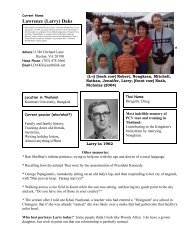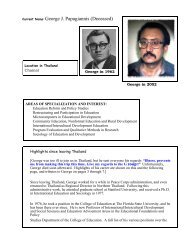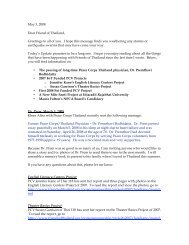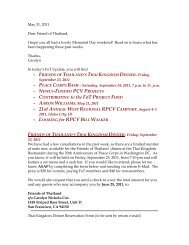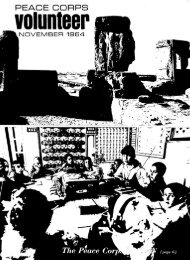TIMES
Peace Corps Times - March/April 1985 - Peace Corps Online
Peace Corps Times - March/April 1985 - Peace Corps Online
- No tags were found...
You also want an ePaper? Increase the reach of your titles
YUMPU automatically turns print PDFs into web optimized ePapers that Google loves.
Ask Almani~c -<br />
After the Harvest<br />
Many Volunteters work to help the<br />
members of their host communities<br />
produce more an,d better food crops.<br />
In either primjary or secondary<br />
projects, voluntAers assist farmers,<br />
fishermen, youth groups, women's<br />
groups and others in a variety of food<br />
production activitiies. These range<br />
from growing fiel:j crops, planting<br />
fruits and vegetables and keeping<br />
bees to raising s$iall animals and<br />
growing fish in porikds.<br />
But production is only one side of<br />
the food equation. !Preserving, storing<br />
and marketing a,he harvest must<br />
be given equal attention in any effort<br />
to increase the availa!bility of food in<br />
1<br />
the community.<br />
Post-harvest food Id~sses due to inadequate<br />
storage can'! amount to as<br />
much as 30 percent of .the crop. Marketing<br />
any surpluses,' especially of<br />
perishable crops like vkgetables, is often<br />
difficult for farmeirs in remote<br />
areas. Improved methodis for storing,<br />
preserving and marketing must be<br />
considered right along wjith methods<br />
for improving food pr4,duction in<br />
planning community agricultural<br />
projects. i.<br />
Smoking to preserve fish.:<br />
ICE has a number of pubi,ications<br />
to assist in these essential post-harvest<br />
efforts. (Please note those titles which<br />
are only available on a limited: basis.)<br />
GENERAL<br />
Post-Harvest Food Losses Developing<br />
Countries provides an herview<br />
of the problem of losses between<br />
harvest and consumption. The ti,ook<br />
discusses various policy and progl-am<br />
options for decreasing these 1osse':s in<br />
grains, perishables and fish.<br />
I<br />
Remote Areas Development MA n-<br />
ual contains designs for several typ!es<br />
of harvestinglprocessing equipme$<br />
and describes methods for dr,ying<br />
fruits and vegetables and tanning<br />
hides.<br />
Directory of International Txoade,<br />
1984 provides detailed informzition<br />
on organizations, companies and promotional<br />
groups involved in th.e iilternational<br />
produce trade. The 1)ook<br />
also lists exporters and importel-s of<br />
specific produce items on a ~couritr~by-country<br />
basis. (Availablci to; PC<br />
offices/resource centers ir~couintry<br />
only.)<br />
Agricultural Marketing ~ribciples:<br />
A Training Manual is it manual<br />
for trainers working in formal inservice<br />
training programs. rktivi ies<br />
in the manual are designed' to h %.Ip<br />
trainees view marketing as a s ystem \of<br />
interrelated components an d cov~er<br />
information collection, describing lbcal<br />
commodity systems and the role c)f<br />
the extension worker in the system.<br />
1<br />
FOOD DRYING<br />
How to Build a Solar Dryer describes<br />
and provides construction details<br />
for a simple solar dryer designed<br />
for use in Papua New Guinea.<br />
Improved Food Drying and Storage<br />
Training Manual provides training<br />
guidelines and construction details<br />
for building and using improved<br />
grain storage facilities and solar grain<br />
dryers. The manual is designed for<br />
use by trainers working in formal<br />
programs to transfer relevant skills,<br />
but contains many trainee handouts<br />
that could be used in field projects.<br />
Solar and Energy-Conserving<br />
Food Technologies Training Manual<br />
is also designed primarily for use by<br />
trainers in formal programs. The emphasis<br />
in this manual is on drying ancl<br />
storing fruits, vegetables and fish.<br />
Handouts also contain informatiori<br />
on "fireless cookery".<br />
Preserving Food by Drying: LL<br />
MathJScience Teaching Manual ex -<br />
plains the principles of evaporation,<br />
condensation, etc. involved in solair<br />
food drying through class construcl<br />
tion of simple solar dryers. This man -<br />
ual would be especially useful foiteachers<br />
and others working with<br />
youth groups.<br />
FRUITS AND VEGETABLES;<br />
Guide to (Almost) Foolproof Gar-.<br />
dening describes a variety of method:;<br />
for preserving the garden harvest for.<br />
home use. Although the book is very.<br />
U.S.-oriented, many of the low-cost<br />
techniques it suggests could be<br />
adapted for use in d~eveloping countries.<br />
Handling Transptortation and<br />
Storage of Fruits andl Vegetables is<br />
available in two volun~es. Volume I<br />
addresses melons and vegetables;<br />
Volume I1 covers fruits and nuts. The<br />
books contain a wealth of information<br />
on all aspects of preparing these<br />
crops for marketing. However, the<br />
material is very technical and U.S.-<br />
oriented. This book would be most<br />
useful for those involved in largescale<br />
commercial projects. (Available<br />
to PC offices/resource centers incountry<br />
only.)<br />
Commercial Vegetable Processing<br />
provides detailed information on the<br />
equipment and processes required<br />
for large-scale commercial canning,<br />
freezing and dehydration of vegetables.<br />
This book is also very technical<br />
and U.S.-oriented, but would be useful<br />
to Volunteers involved in largescale<br />
processing ventures. (Available<br />
to PC offices/resource centers incountry<br />
only.)<br />
Fruit and Vegetable Juice Processing<br />
Technology discusses commercial<br />
methods of preparation for<br />
fruit juices and concentrates made<br />
from pineapples, guavas, lemons,<br />
oranges and tomatoes. The technology<br />
described is somewhat more<br />
accessible to most developing countries,<br />
but is still more appropriate to<br />
large-scale ventures.<br />
MEATS AND FISH<br />
Homesteader's Handbook for<br />
Raising Small Livestock covers all<br />
aspects of husbandry for poultry,<br />
:sheep, goats and pigs. The book describes<br />
butchering and simple presertation<br />
techniques as well as use of anilnal<br />
by-products.<br />
.Slaughtering, Cutting and Processing<br />
Pork on the Farm outlines the<br />
steps involved in preparing and proces$ing<br />
hogs for the marketplace. Information<br />
on curing, pickling and<br />
smoking could be adapted for use in<br />
developing communities.<br />
I<br />
Cai~ning, Freezing, Curing and<br />
Smoq~ng of Meat, Fish and Game<br />
covers, a wide variety of simple techniques;<br />
for preserving meat and fish<br />
for home use. Well-the title says it<br />
all, doesn't it?<br />
(continued on page 24)<br />
Peace Coi-ps TimesIICE Almanac 19



